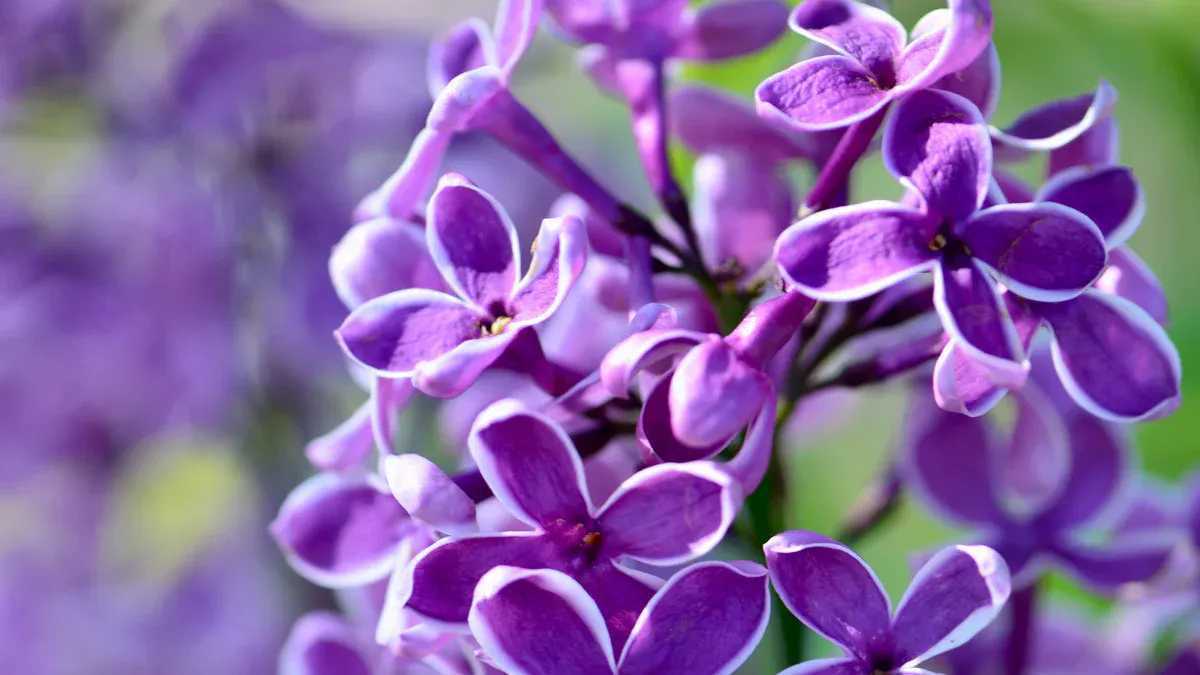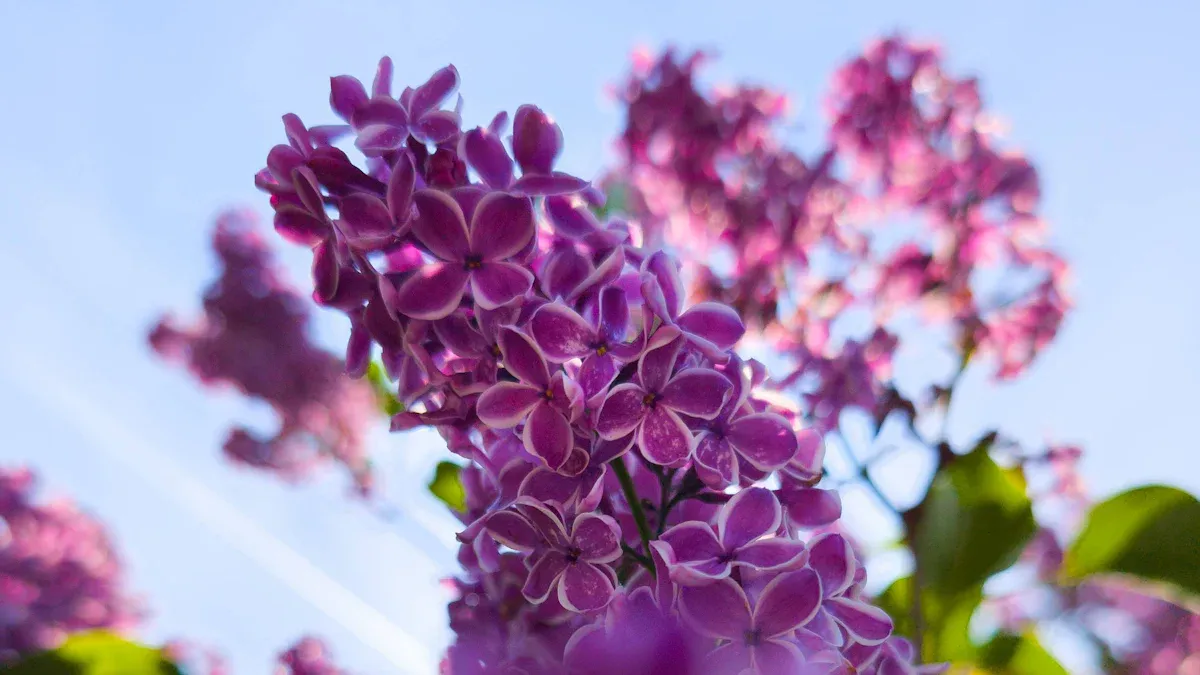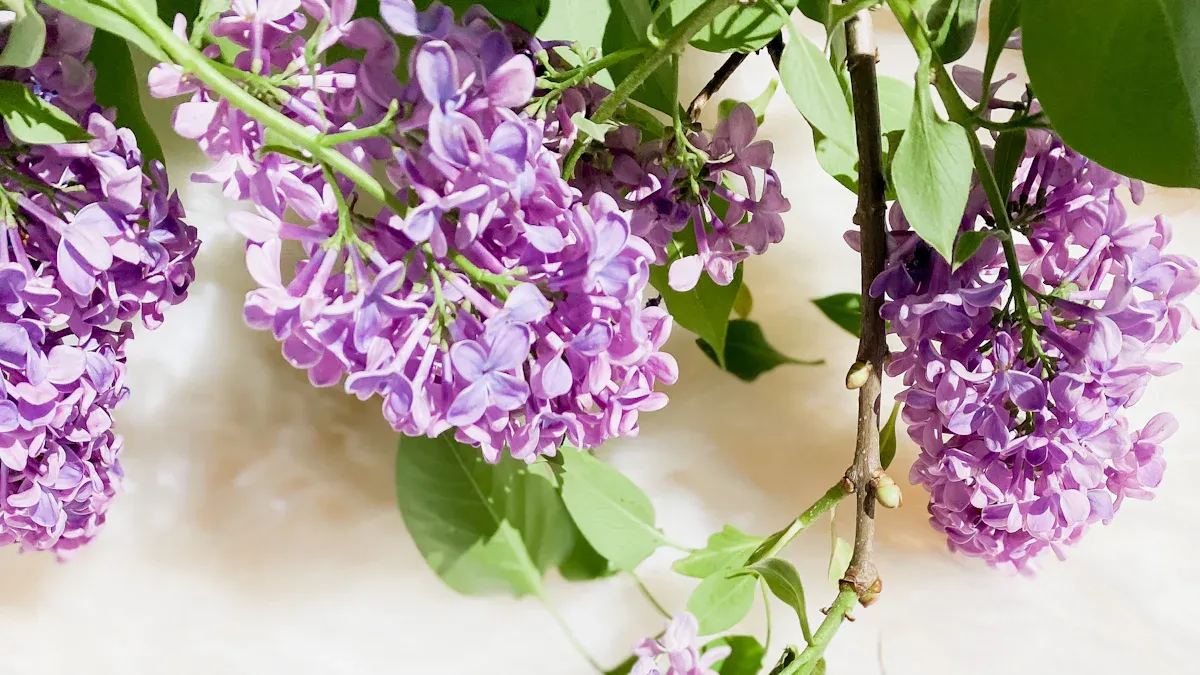
Lilacs bring a delightful charm to any garden, filling the air with their sweet fragrance and vibrant colors. However, many gardeners struggle with getting them to bloom. Common issues include late freezes, excess nitrogen, and insufficient sunlight. By understanding these challenges, you can make your lilacs thrive and bloom boldly each year.
Key Takeaways
Choose a sunny location for your lilacs. They need at least six hours of direct sunlight daily to bloom beautifully.
Space your lilacs properly to promote air circulation. Follow spacing guidelines to prevent overcrowding and encourage healthy growth.
Water your lilacs deeply and regularly. Aim for about an inch of water weekly, adjusting based on weather conditions.
Make Your Lilacs Thrive in the Right Location

When it comes to making your lilacs bloom boldly, location is everything. You want to ensure they get the right amount of sunlight and have enough space to grow. Let’s dive into these two crucial factors.
Sunlight Needs
Lilacs are sun-loving plants. They thrive best when they soak up plenty of sunlight. To ensure healthy growth and abundant blooms, lilacs must receive at least six hours of direct sunlight daily. This is especially true for varieties like the Double Bloom Lilac, which requires this minimum to produce a rich display of flowers.
Tip: If your lilacs don’t get enough sunlight, you might notice fewer blooms or even stunted growth. So, choose a spot in your garden that gets plenty of sun!
Space Considerations
Giving your lilacs enough space is just as important as sunlight. Crowded plants can lead to poor air circulation, which can invite pests and diseases. Here’s a quick guide on how much space to provide between different types of lilacs:
Lilac Type | Recommended Spacing |
|---|---|
Common lilac | 6–10 feet apart |
Dwarf lilacs | 3–5 feet apart |
Tree lilacs | 10–15 feet apart |
By following these spacing guidelines, you’ll help your lilacs flourish and create a stunning display in your garden. Remember, the right location can make all the difference in how your lilacs bloom each year!
Soil Preparation for Your Lilacs
To make your lilacs bloom boldly, you need to start with the right soil. Lilacs prefer well-drained, nutrient-rich soil that allows their roots to thrive. Let’s explore the ideal soil type and pH levels for these beautiful plants.
Ideal Soil Type
Lilacs flourish in moist, well-drained soil. They don’t do well in waterlogged conditions, so it’s crucial to avoid areas where water tends to pool. Here are some key points to remember:
Good drainage is essential; lilacs do not thrive in wet conditions.
Moist, well-drained soil is crucial for healthy growth.
If your soil is heavy clay or tends to retain water, consider amending it with organic matter like compost. This will improve drainage and provide nutrients that lilacs love.
pH and Drainage
The pH level of your soil plays a significant role in lilac health. Aim for a pH between 7.0 and 8.0, which indicates slightly alkaline conditions. Here’s what you should know:
The optimal pH for lilacs is between 7 and 8.
Lilacs thrive in neutral, slightly acidic, or slightly alkaline soil.
Poor drainage can lead to root rot, which hinders growth and blooming. To prevent this, ensure proper watering practices and focus on maintaining well-drained soil. Remember, healthy roots equal vibrant blooms!
Tip: Test your soil’s pH regularly to keep it within the ideal range. This simple step can make a big difference in how your lilacs perform.
Watering Practices for Lilacs
Watering your lilacs correctly is crucial for their health and blooming potential. Let’s explore the best techniques and how often you should water them.
Proper Techniques
When watering lilacs, aim for deep and thorough soaking. Here are some effective techniques to consider:
Water newly planted lilac bushes with about an inch of rainfall every 10 days.
In dry conditions, provide a thorough soaking using a hose.
Use a trickling garden hose or a soaker hose for effective watering.
These methods help ensure that water penetrates deeply into the soil, reaching the roots where it’s needed most.
Frequency of Watering
The frequency of watering depends on the age of your lilacs and the weather conditions. For established lilac bushes, follow these guidelines:
Water once a week in spring.
Increase to twice a week in summer, especially during dry spells.
Each watering session should provide about 1 inch of water. This routine helps keep the soil moist but not soggy.
Be cautious, though! Overwatering can lead to mushy roots and root rot, while underwatering causes crispy leaf edges and wilting. Both conditions stress your plants and can reduce bloom production.
Tip: Adjust your watering based on the weather. If it rains, you might skip a session. Keeping your lilacs happy means paying attention to their needs!
By mastering these watering practices, you’ll help make your lilacs bloom boldly every year!
Pruning Your Lilacs for Optimal Blooms
Pruning is a vital step in ensuring your lilacs bloom beautifully each year. It helps promote healthy growth and encourages more flowers. Let’s explore when to prune and how to rejuvenate older lilac bushes.
Timing for Pruning
Timing your pruning correctly can significantly influence the number of blooms your lilacs produce. Here are some key points to keep in mind:
Prune Soon After Blooming: The best time to prune lilacs is right after they finish blooming. This timing allows you to avoid cutting off next year’s flower buds, which start forming in the summer.
Focus on New Growth: Lilacs produce more blooms on healthy, newer growth rather than on older stems. By pruning at the right time, you encourage fresh growth that will yield vibrant flowers.
Tip: Mark your calendar! Pruning right after blooming ensures you get the most out of your lilacs each year.
Rejuvenation Techniques
If your lilacs have become overgrown or neglected, rejuvenation pruning can help restore their health and blooming potential. Here’s how to do it effectively:
Timing is Key: Perform rejuvenation pruning during late winter or early spring, just before new growth begins. This timing helps the plant recover quickly.
Avoid Drastic Cuts: While it’s essential to remove old wood, don’t go overboard. Aim to remove no more than 20% of live wood at any given time to prevent shocking the plant.
Work With Clean Tools: Always use clean pruning tools to avoid transferring diseases to your lilacs.
For mature lilac shrubs, consider a three-year rejuvenation cycle. Here’s a simple guide:
Year | Action | Timing |
|---|---|---|
1 | Remove one third of the largest stems | Late winter |
2 | Prune out another third of the thickest stems | Late winter |
3 | Repeat the process again | Late winter |
This method allows for continuous blooming since lilac wood needs to be at least three years old to flower. If your shrub looks scraggly, you might even consider cutting it back to just a few inches above the soil surface. This drastic approach can rejuvenate older lilacs, as seen in cases where 20+-year-old plants rebounded beautifully after such treatment.
By following these pruning techniques, you’ll help your lilacs thrive and bloom boldly every year!
Fertilizing to Make Your Lilacs Bloom

To make your lilacs bloom boldly, proper fertilization is key. Choosing the right fertilizers and applying them correctly can significantly enhance your lilac’s blooming potential. Let’s explore the best options and methods for fertilizing your lilacs.
Recommended Fertilizers
Lilacs thrive on fertilizers with higher phosphorus content and lower nitrogen levels. A great NPK ratio to look for is 5-10-10, which means 5% nitrogen, 10% phosphorus, and 10% potassium. This combination supports blooming while promoting strong roots and lush foliage.
Tip: Avoid fertilizers with excessive nitrogen. Too much nitrogen can lead to vibrant green leaves but few blooms. Here’s a quick overview of the effects of high nitrogen:
Source | Evidence |
|---|---|
Plant Addicts | Lilac plants do not need a lot of fertilizing or organic feeding. |
House Digest | Adding too much fertilizer encourages lush foliage growth with fewer blooms. |
Birds and Blooms | Avoid high nitrogen fertilizer because it can prevent flowering. |
Application Methods
Applying fertilizer correctly ensures even nutrient distribution. Here’s how to do it:
Fertilize early in spring, just before or after new leaves appear.
Use a broadcast spreader for granular fertilizers to ensure even application.
For liquid fertilizers, dilute them with water for uniform distribution.
Spread a few cups of granular fertilizer around the root zone of each bush.
Rake the fertilizer into the surface to help release nutrients.
Top it off with an inch of compost to hold the fertilizer and provide extra nutrients.
By following these steps, you’ll help your lilacs absorb the nutrients they need for a stunning display of blooms!
Managing Pests and Diseases
Lilacs can face several pests and diseases that threaten their health and blooming potential. By identifying these issues early, you can take action to protect your plants.
Common Pests
You might encounter a few common pests that can wreak havoc on your lilacs:
Lilac borer: This pest tunnels into the main stems, causing wilting during hot weather. Infested lilacs may suffer from branch dieback, leading to fewer blooms.
Lilac-ash borer: A clearwing moth lays eggs on the bark, and the larvae tunnel into the wood. Heavy infestations can also result in branch dieback, negatively impacting blooming.
Disease Prevention
Preventing diseases is just as important as managing pests. Here are some common diseases that can affect lilacs:
Fungal leaf diseases like Septoria and powdery mildew can cause yellowing and dropping of leaves. This reduces photosynthesis and overall plant health.
Bacterial blight leads to water-soaked spots on stems and leaves, which can quickly blacken and kill leaves and flower clusters.
To keep your lilacs healthy, follow these preventative measures:
Maintain a clean and well-ventilated growing environment.
Avoid overhead watering to keep foliage dry.
Space lilacs adequately for good air circulation.
Water at the base to prevent bacterial growth.
Add a 2 to 3-inch layer of mulch around the base to retain moisture and prevent soil-borne bacteria from splashing onto leaves.
Apply an organic, copper-based pesticide spray in early spring to protect against infections.
Regularly prune to improve air circulation and remove fallen leaves or debris.
By staying vigilant and following these tips, you can help your lilacs thrive and bloom boldly every year! 🌸
Seasonal Care for Your Lilacs
Taking care of your lilacs throughout the year is essential for vibrant blooms. Here’s a month-by-month guide to help you keep your lilacs healthy and happy.
Month-by-Month Guide
January to February: Focus on pruning your lilacs during late winter. Remove any dead or damaged branches to encourage new growth.
March: As the weather warms, check for any signs of pests. Apply a dormant oil spray if needed.
April: Fertilize your lilacs with a balanced fertilizer. This will give them the nutrients they need as they start to grow.
May: Enjoy the blooms! Keep an eye on watering, especially if it’s dry. Water deeply once a week.
June: After blooming, prune away spent flowers to encourage new growth. This helps prepare your lilacs for next year.
July to August: Continue watering and mulching to retain moisture. Watch for pests and diseases.
September: Fertilize again to support root development as the season changes.
October to December: Prepare your lilacs for winter by mulching around the base. This protects the roots from freezing temperatures.
Staggered Blooming Varieties
To enjoy lilacs for a longer period, consider planting varieties that bloom at different times. Here are some popular options:
Early Varieties (early-to-mid May):
Pocahontas Canadian Lilac
Bloomerang® Dark Purple Lilac
Declaration Lilac
Mid-season Varieties (mid-to-late May):
Chinese Lilac
Charles Joly Lilac
Sensation Lilac
Late Season Varieties (late May to early June):
Miss Kim Korean Lilac
Ludwig Spaeth Lilac
Old Glory Lilac
By mixing these varieties, you can extend the blooming season and enjoy the beauty of lilacs from spring into early summer. Remember, changes in temperature and precipitation can affect blooming patterns. If your lilacs bloom unexpectedly in the fall, it might be a sign of stress. Stay attentive to their needs, and you’ll have a stunning display year after year! 🌼
To make your lilacs bloom boldly every year, remember these essential tips:
Remove old blooms right after flowering.
Add compost at the base during summer.
Water deeply, ensuring about an inch of rainfall weekly.
Implement these practices, and enjoy vibrant lilac blooms! 🌸 Share your experiences or questions about lilac care below!
FAQ
What should I do if my lilacs aren’t blooming?
Check their sunlight, water, and soil conditions. Ensure they receive at least six hours of sunlight daily.
How often should I prune my lilacs?
Prune lilacs right after blooming each year to encourage new growth and more flowers.
Can I grow lilacs in pots?
Yes, you can grow lilacs in pots. Just ensure they have enough space and proper drainage for healthy growth. 🌱

